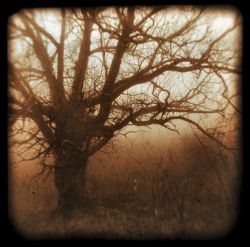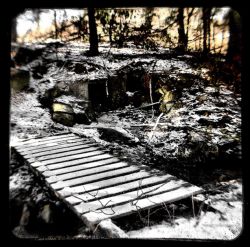 On one of my previous posts I shared 5 Tips for Acquiring Old Cameras. One of the comments on this post was made by Jessica where she simply stated "Then again, if they don’t work, you could always use them for TtV!".
On one of my previous posts I shared 5 Tips for Acquiring Old Cameras. One of the comments on this post was made by Jessica where she simply stated "Then again, if they don’t work, you could always use them for TtV!".
I had heard of TtV before but, as a technique, was something that I was never curious to experiment with. But my curiosity definitely spiked after seeing some of Jessica’s photos using this method and I’ll be trying it in the near future.
So, I asked Jessica if she could go a little further on the subject of TtV, not only for me, but for all my readers that are not so familiar with the technique.
And here is what Jessica had to say…
TtV / Tee Tee Vee / abbr.
Through The Viewfinder: The technique of using one camera to take a picture via another camera’s viewfinder.
Your first impression may be that the technique sounds somewhat absurd. I’m here to tell you that the results are simply stunning. Let me fill you in on this method that will have you scrambling to get your hands on a camera of your own to try out this fairly new technique.
The Cameras
In order to achieve the highly unique and nostalgic, square format look, you will first need to acquire a base camera. Typically, the bottom viewing camera is a TLR, a twin lens reflex, which has a waist-level, bubble-like viewfinder. The viewfinder happens to be one of the most charming aspects of this method, as it creates a slightly out of focus fish-eye effect that is reminiscent of a dream. It also leaves your image with a natural black frame that adds to the already vintage look.
Some of the most commonly used TLR’s are the Kodak Duaflex, Starflex, and Brownie. Some other manufacturers to consider are Argus and Anascoflex; although, this doesn’t scratch the surface of everything that is available. If you’re not lucky enough to find one of these types of cameras locally, you should have no problem finding one through the ever-so-popular Ebay to locate a retro treasure of your very own. An extremely informative article is "5 Tips for Acquiring Old Cameras".
The Method
 Finding a TLR that actually works isn’t necessary – since you don’t need to use film. However, there are certain warnings to regard when buying based on descriptions and photos alone. The old-fashioned look obtained with the method is in part due to how the camera shows age with dirt, dust, and scratches. As these conditions can enhance the dirty-lens style, you don’t want the imperfections to be so bad that they become an obstruction. I have yet to do this myself, but you can carefully take the camera apart to clean the lenses in the event that you find one with oodles of mold or very thick dust. Another possible impediment may be those lenses which contain grid lines or bullseye type marks on the viewfinder, which in turn becomes a part of your photo. Although you may like the outcome of that result.
Finding a TLR that actually works isn’t necessary – since you don’t need to use film. However, there are certain warnings to regard when buying based on descriptions and photos alone. The old-fashioned look obtained with the method is in part due to how the camera shows age with dirt, dust, and scratches. As these conditions can enhance the dirty-lens style, you don’t want the imperfections to be so bad that they become an obstruction. I have yet to do this myself, but you can carefully take the camera apart to clean the lenses in the event that you find one with oodles of mold or very thick dust. Another possible impediment may be those lenses which contain grid lines or bullseye type marks on the viewfinder, which in turn becomes a part of your photo. Although you may like the outcome of that result.
Before you decide to join the ranks of TtV photographers, there are other facets of the craft that you need to prepare for. In addition to the base camera we talked about earlier, you will need a macro lens and a contraption, which seals out light. With the macro lens attached, you will want to measure the distance that you must maintain to get your digital camera to focus through the TLR’s viewfinder. Doing this will determine how tall your contraption needs to be. Without this, it is a lot harder to get a properly exposed shot. Once you’re ready to make a contraption, take a look around the house, chances are you have materials laying around that can be quickly fashioned into something suitable; I’ve even seen some made from cereal boxes before. To get an idea, please check out my contraption.
Getting started with this new technique is the easy part, but learning to manage and maneuver two cameras at once proves to be a bit of a challenge at times. However, I am of the opinion that the results are well worth the extra effort involved to capture such captivating images. You can find many ideas as well as inspiration within the "Through The Viewfinder" flickr group. I encourage you to peruse the forum for any further questions you may have about the technique. I sincerely hope that you found this information to be useful, although it is not intended to be a definitive guide by any means.
The Author
Originally from Florida, Jessica Maceda currently resides within the Blue Ridge Mountains of Western North Carolina. She carries with her a deep appreciation for nature, and an unwavering passion for photography. Many of her experiences are shared through a blog called Wayfaring Wanderer. You can also find her photos (including TtV work) on her flickr photostream.
tom
July 9, 2008 at 2:27 pm
Jessica,
Great post. Your “contraption” made beautiful photos!
We tried this a while back and wrote about it on our blog here:
http://1000words.kodak.com/search/default.asp?item=273519
It was so popular we helped support “World Through the Viewfinder Day,” a holiday that will be growing in popularity to be sure ;-). A post about that is here:
http://1000words.kodak.com/search/default.asp?item=495305
The photos in your flickr photostream have a dreamy quality about them.
Take care – Tom from Kodak
Pingback: Link Roundup 07-12-2008
A Marques
July 13, 2008 at 11:44 pm
Hi Tom,
I don’t know if Jessica will be around to answer your comment (as you may have noticed this was a guest post).
In any case, I’ve read your post on TtV and, together with Jessica’s, I can only say that I’m more and more interested in the technique. For sure I’ll follow her advice and will try the technique soon.
Thanks for dropping by.
Embassy Pro Books
July 23, 2008 at 10:02 pm
Fantastic post, I’m glad you delved deeper into Jessica’s post on TvT
the_wolf_brigade's GAS is incurable
September 12, 2008 at 12:27 pm
Hmm. I really should give this a proper attempt. I’ve tried, but it’s tricky to do well…